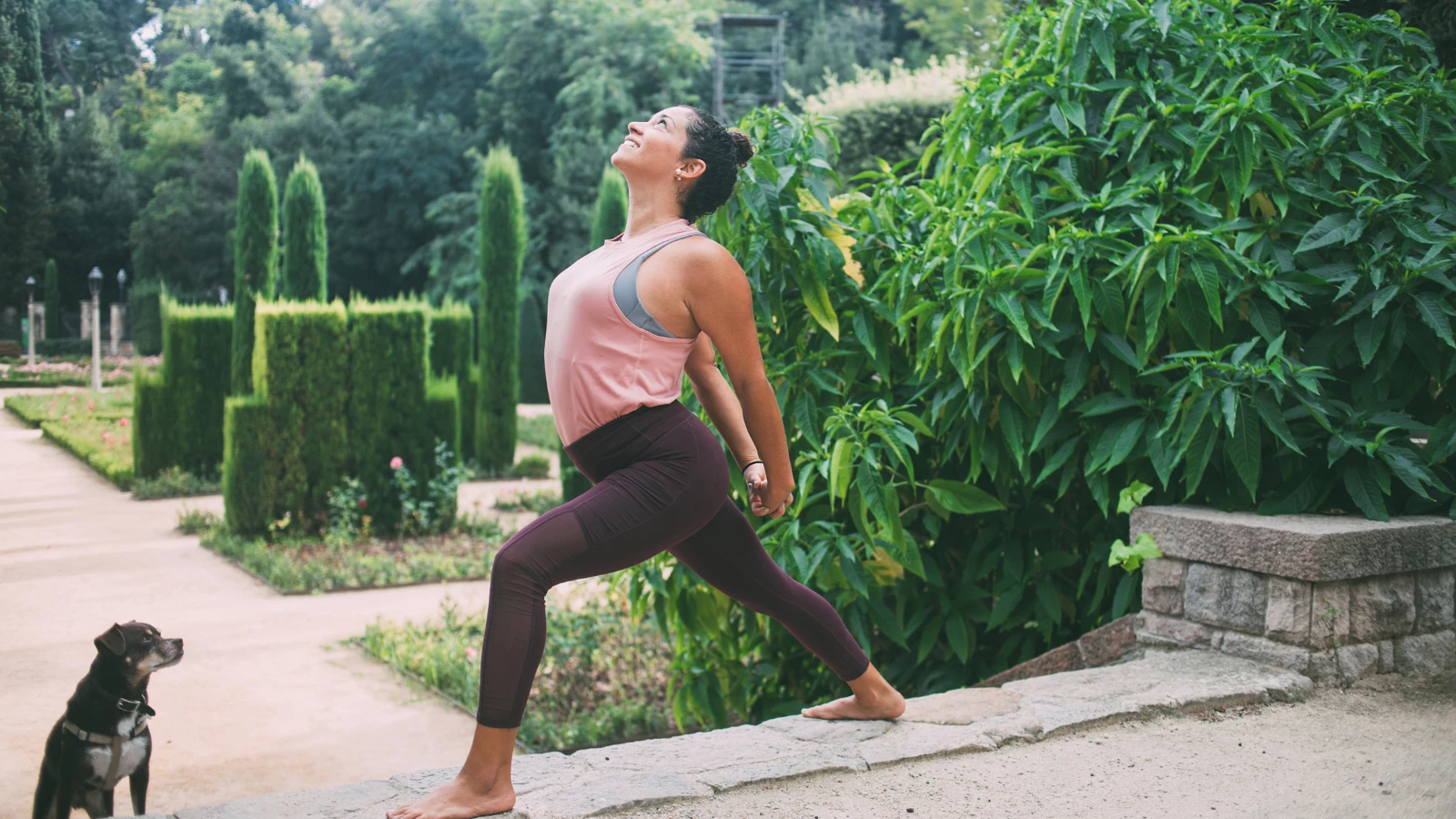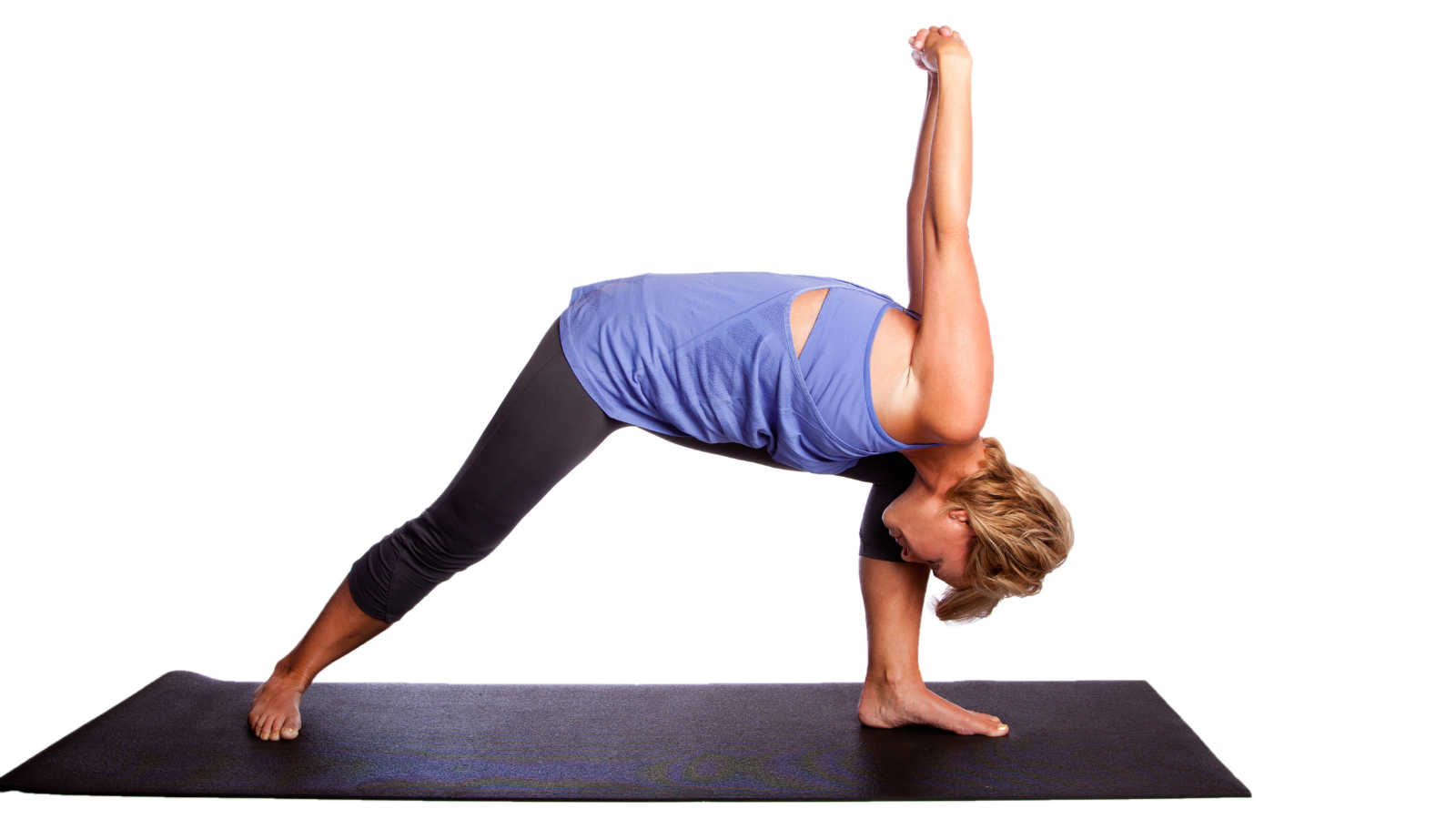3 IT Band Stretches for Road Warriors

Article At A Glance
Road warriors: we see them running or cycling. Perhaps you are one or have been one yourself. These physical activities have many great health benefits but can also cause the iliotibial (IT) band to get tight, irritated, and inflamed. IT band yoga stretches can help lengthen and release this area and, as part of a holistic recovery plan, bring relief.
The iliotibial (IT) band is a band of fascia (dense, tough connective tissue) running along the outer thighs. IT Band Syndrome is common in runners and cyclists. Its symptoms include lateral knee pain resulting from friction between the IT band, a muscle attachment site on the thigh bone, and thigh and buttock pain.
That friction comes from repetitive flexion and extension of the knee joint. (Note how much knee bending and straightening occurs in running and cycling.) Occasionally, surgery is necessary for full recovery, but non-surgical approaches can often suffice (1). Non-surgical strategies can include IT band syndrome yoga, which can begin to release tension in the area enough to ease that friction.
IT Band Yoga: It’s About Holistic Balance

It’s important to note that the goal here is balance. It’s very much possible to overstretch the IT band, particularly for those with a less active lifestyle. People who are less active most often don’t need the sort of release in this area that runners and cyclists do. Fascia, unlike muscle, can’t go back to an original length when stretched. Overstretched fascia can’t do the stabilizing job it’s meant to, leading to other anatomical and biomechanical issues.
Strengthening the abductors (which lift the leg to the side) and stretching the muscles surrounding the IT band (including the gluteus muscles, quadriceps, and hamstrings) can help ameliorate IT band issues for those who aren’t “road warriors.” A balanced yoga practice, with perhaps some specialized poses and pose variations—including both movement and stabilizing, such as balancing—can catalyze that healing process.
The key thing is finding balance through a holistic approach. The yoga that will serve you best takes into consideration the demands on your physical system as a whole, on and off the mat. The yoga that will nurture me is not necessarily the yoga that will nurture you, and vice-versa. We’re all different people with different lives and different bodies.
For runners and cyclists or anyone on their feet and moving for hours a day, these pose variations can help offer what they need for IT band relief. As always, proceed mindfully and with a spirit of Ahimsa (non-harming). Consult your healthcare provider(s) before beginning yoga or any physical practice or program to address any particular condition.
Half Split Variation: IT Band Stretches
- Take a Low Lunge Pose (Anjaneyasana) with your right foot forward.
- If your back knee feels sensitive here, place a blanket under it. If the floor feels far away, place one block under each of your hands.
- Notice the length through your spine. As you breathe in, see if you can lengthen out any further.
- As you breathe out, shift back so that your left hip is right over your left knee. Make your right toes bright, pointing upward toward your torso.
- If it feels wise for you today, move into an IT band yoga stretch variation of this pose. Walk your hands over to your left, taking your blocks with you if you’re using them. Point your toes more to the right, still upward but diagonal in that direction. Calibrate how deeply you go into this pose according to what you feel here. It is your pose, absolutely no one else’s.
- Breathe here for 5 to 10 breaths. Can you feel longer through your spine with every breath in and deepen into the pose with every breath out? Of course, if you’re experiencing any sharp pain, or this just doesn’t feel right, come out of the pose entirely.
- Bend back into your right knee on a breath in to come back to Low Lunge Pose. Take your right foot back to your left foot so that you’re in Tabletop Pose (Bharmanasana). Let yourself enjoy any movements that your body may be calling for here.
- Repeat steps 1 through 7 on the other side of your body, with your left foot forward.
- Take a moment to simply notice your breath, any sensations from your body, and the quality of your thoughts before proceeding.
Forward Bend Variation: Criss-Cross and Stretch
- Come to a Standing Forward Bend Pose (Uttanasana). Stand with either your big toes together and your heels just a bit apart, about a quarter of an inch, or with your feet hip-distance apart, about two fists in between your feet.
- Feel your low belly meeting your upper thighs. Bend your knees as much as you need to make that happen.
- If your hands are far from the floor, place them on blocks or on the seat of a chair.
- Check in for a moment with where your weight is on your feet. Are you hanging back on your heels? If so, shift your weight slightly forward so that your weight is distributed evenly on the four corners of both feet.
- Cross your left ankle directly behind your right ankle. Your left shin will be behind your right calf. Check again with your weight distribution, and shift forward again if you need to.
- Maybe this is enough for you today. To go deeper, for some IT band rehab, walk your hands over to the right, with your blocks if you’re using them. The amount that your body is telling you is right for you today. Calibrate accordingly.
- For 5 to 10 more breaths, breathe into the outer line of your left leg. If accessible to you, feel a little longer through your spine with every breath in, and just a bit deeper into the pose as you breathe out.
- As long as it’s not a sharp pain, breathe into the sensation that you feel. What information might it have for you? If it is sharp pain, or this just doesn’t feel right, try something else out or come out of the pose.
- Uncross your ankles. Take a moment to feel anything notable from your body before proceeding. When you’re ready to, repeat steps 1 through 8 on the other side of your body, crossing your right ankle behind your left ankle.
- Take a moment to check in again before moving on. How are these IT band yoga poses for you today? What are your thoughts?
Humble Warrior II: Grounding and Reaching
- Set up Warrior II Pose (Virabhadrasana II) with your right foot forward. Position your feet a few feet apart, your front toes pointing to the top of your mat and your back toes angled forward about 30 to 45 degrees.
- Clasp your hands behind your lower back, interlacing your fingers. Feel spacious through your collarbones. If you can’t reach your hands directly downward, gently bend your elbows. If your hands can’t quite reach each other, hold a strap between them with your hands shoulder-width apart.
- Breathe in and feel any amount taller through your spine. Breathe out and lower your torso toward your mat, folding right at your hip joints.
- Keep your arms as they are, or reach them forward and down as you would in Downward Facing Dog Pose (Adho Mukha Svanasana). With your arms shoulder distance apart or a bit wider, press into your hands with fingers spread wide. If the floor feels far away, use blocks under your hands.
- Did your right hip start winging further out to the right? Draw it gently in and back toward your left heel. Is your front knee falling inward? Engage your front thigh to keep that knee in line with your front hip. Draw your heels toward each other to keep your hamstrings active. All of these actions will help keep your pose stable. This is a challenging pose, so that can make a big difference!
- Stay here for 5 to 10 breaths, making any necessary adjustments or coming out of the pose early if needed. As long as it’s not pain, can you breathe into the sensation that you feel?
- To come out of the pose, walk your hands to frame your front foot, one on either side, and press into your mat or your blocks. Then step your back foot forward to meet your front foot. Breathe in and raise your torso back up to Mountain Pose (Tadasana).
- Take a moment to notice how you feel, and then take the pose on the other side: repeat steps 1 to 7 with your left foot forward. Complete both sides by taking another moment to simply notice. You’ve done your IT band yoga. Happy running and cycling!
Also, read...
4 Yoga Poses to Strengthen the 4 Muscles of the Rotator Cuff
7 Yoga Teaching Tips I Wish I’d Learned Sooner
Related courses
Keys to Finding Inner Strength: A Yogic Wisdom Path to Developing Greater Resilience
Somatic Yoga for Fascial Unwinding

Kathryn Boland is an RCYT and R-DMT (Registered Dance/Movement Therapist). She is originally from Rhode Island, attended The George Washington University (Washington, DC) for an undergraduate degree in Dance (where she first encountered yoga), and Lesley University for an MA in Clinical Mental Health Counseling, Expressive Therapies: Dance/Movement Therapy. She has taught yoga to diverse populations in varied locations. As a dancer, she has always loved to keep moving and flowing in practicing more active Vinyasa-style forms. Her interests have recently evolved to include Yin and therapeutic yoga, and aligning those forms with Laban Movement Analysis to serve the needs of various groups (such as Alzheimer’s Disease patients, children diagnosed with ADHD, PTSD-afflicted veterans – all of which are demographically expanding). She believes in finding the opportunity within every adversity, and doing all that she can to help others live with a bit more breath and flow!
Resources
- Pierce MD, Todd P. “Iliotibial band lengthening: an arthroscopic technique”. Arthroscopy Techniques Volume 6, Issue 3. 2017 June. <https://www.sciencedirect.com/science/article/pii/S2212628717300452>





